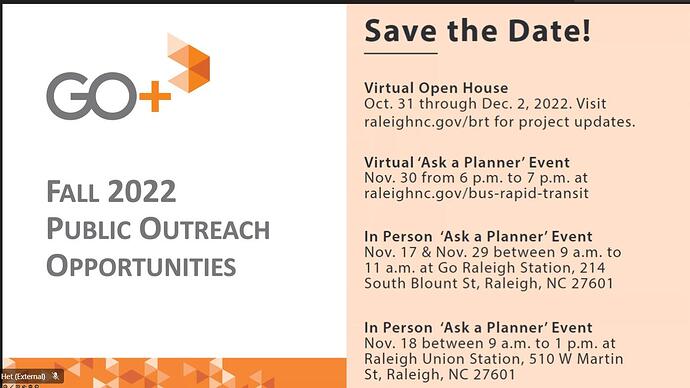Man. I just can’t believe it. Construction to start summer 2023. ![]()
Thanks for sharing. Im going to be paying attention to those flags and construction
I’m listening in on a BRT stakeholder meeting. Nothing huge here I think, kind of soft updates on each of the BRT corridors but I snapped these screens for the New Bern BRT route just in case anyone hasn’t seen them.
I’m so curious if that station on Wilmington will be comfortable cause that rendering makes the sidewalk look busy and cramped.
Does anyone know if they have plans/design to connect the Western line to the fairgrounds/PNC/Carter-Finley? I know the actual Western route doesn’t connect, but to be able to hop on a BRT downtown to get out to that area and back would be great. Even if there were a nice walking path between the BRT and that area would be nice, but it’s pretty well divided by the tracks.
Anyone know the proposed frequencies for these routes? I really think shooting for headways <=10 mins would do the most to help this thing succeed.
Also, would love to see some bike racks at/near the stations!
I thought they would have 15 min frequency for the majority of the day, 7 days a week.
Not sure the background of this organization, but this morning on a meeting with Joe Milazzo from RTA. He described BRT as “borderline spectacular” including equity and moving fast. It was interesting.
I asked this question and didn’t get a solid answer (maybe because of how I asked it and the fast pace of presenting live to a group).
“What’s your thought on how to increase speed of transit development and reduce costs through policies that concentrate authority and reduce the layers of approval (Fed, stat, local + neighborhoods). Or, it that’s not a barrier, put another way, what are the drivers of costs and delay of projects”
What I heard was generally that funding from the feds at 50% is important and sometimes transportation groups will decide to fully fund to move faster.
Many folks behind this project, will have to get their piece of the pie before this project gets moving. That’s just Raleigh politics. It will be skimmed back mark my words.
Does anyone know where we can go to have these organizations and politicians audited?
RTA is an interesting group. It’s primarily composed of local business leaders, many of which are based in RTP from what I can tell. As such, they approach pretty much everything from the angle of “what will attract more business to the Triangle?” They do some transit advocacy, but they do a lot of highway and airport advocacy as well. They pushed really hard for Complete 540, for example. They also claim to be part of the reason NCDOT has been toying with this stupid Dynamic Left Turn thing.
Their priorities list has slowly but steadily improved over the few years that I’ve been following them, so that’s good, but a lot of their talk concerning improvements to local transit seems to center around the concept of equity, which is a good “buzzword” if you’re trying to draw in more big tech. Not saying it isn’t sincere, maybe it is. I’m just cynical.
To be fair, they have done some good work (I’m very curious if NCDOT will start implementing recommendations from their FAST study). I guess my primary complaint is that they seem to be the only transportation advocacy group in the Triangle (and maybe the entire state) that has the ear of NCDOT, but they dedicate a lot of their efforts to highway expansion. Money talks, I guess.
Sorry for being  .
.
The type of corruption that you say exists must be reported to the Wale County District Attorney or the North Carolina Attorney General. Unless Josh Stein or Lorin Freeman are in on the corruption, it does not exist. NO ONE has brought forth evidence or any allegations that public officials are on the take. If there was anything indicating this kind of corruption, who thinks Livable Raleigh would be all over it. Trump taught us just telling the lie makes it so.
Gonna quickly summarize some updates from the City of Raleigh and CAMPO for y’all:
-
The City is currently running a virtual open house for all four proposed lines. I really haven’t seen much new information in this, just some updated timeline info and a rendering of what the buses might look like (worth noting that these look an awful lot like New Flyer Xcelsiors, though I’m sure that’s not a set-in-stone decision yet). I think they also got rid of that dreaded drop shadow on the “plus” that I kept complaining about. They are asking for some feedback, though I’m honestly having trouble figuring out what exactly it is they want feedback on.
-
CAMPO just tweeted today that they’ve published the results of the Rapid Bus Extensions Study. A quick glance of the draft recommendations indicates that they’ve selected preferred alternatives for both extensions. Both studies also concluded that they expect significantly higher ridership (nearly double in both cases) with a one-seat ride to Raleigh. In other words, the studies seems to recommend that these be actual BRT route extensions, not separate services.
Not much else to report other than that New Bern is expected to break ground in Summer 2023, which means Fall 2023, or Winter 2024, or Spring 2024, or…
Soooo winter 2023 to begin construction is now out. Unbelievable. Costs will be triple by the time ground is actually broken.
The average temperature in December will be 80 degrees by the time this project is finished lol.
I just wish the gas stations @ Raleigh Blvd were 1/1000th as “clean & safe looking” as these renderings indicate
That looks phenomenal. I was worried about bike racks not being included near the stations. Also love that folks can bring their bikes onboard through the rear door.
Also… 10 min peak headways!
I’d like to see bikeshare stations at each stop as well so that folks can ride a bike to catch a bus.
The mainline BRT looks really awesome -but what do we think of the plans to expand “rapid buses” (they’re beefed up buses with quality somewhere between normal buses and BRT) to the edges of Wake County?
How did they compare different routes? (click me!)
This study looked at several options for the southern corridor (Garner Station to Clayton) and western corridor (downtown Cary to RTP). They compared options in each corridor to see which one allowed:
-
access to big destinations, such as supermarkets, hospitals, and dense job clusters;
-
better infrastructure and land use, such as taking advantage of soon-to-come road projects;
-
access to transit for residents, measured based on how many people are served by stations and how routes work together with other local and regional transit services;
-
a more productive, sustainable service in terms of construction and operation costs, travel time, and ridership.
Note that, earlier this year, community members have indicated (and I think it matches our past discussions here) that they cared more about priorities 1 and 4. However, the job of planners and transit agencies is to balance all four of them. Keep in mind that bolded part of priority 3, especially, since we’ll get back to that in just a second.
It turns out that ridership could be roughly doubled if the proposed bus services allow for one-seat rides all the way to downtown Raleigh. That’s 4,500 riders per day on the Garner-Clayton-Raleigh line versus 2,400 if passengers had to make a transfer at Garner Station, and 2,200 for RTP-Cary-Raleigh versus under 1,000 for RTP-Cary alone. These numbers assume that we go with the following routes:
The southern route will keep it simple in Garner, and extend to a major industrial jobs cluster in Clayton. (click me!)
For the southern corridor, where sorta-BRT-like buses could run along US-70 beyond the Wilmington St. BRT line, the study settled on Garner Alternative 2 and Clayton Alternative 2 out of the options below:
This one seems pretty self-evident: Garner Alternative 2 is much simpler, and Clayton Alternative 2 allows workers in the East Clayton Industrial Area to take advantage of better buses (and it’s still close enough to a future rail station).
The western corridor, though, is a bit more of a headache.
The study suggests going through McCrimmon Pkwy. instead of Davis Dr. like people wanted. (click me!)
This corridor had three different options for routes, and it turns out over 75% of community members (including some of us on here) saying that all three options “‘met’ or ‘somewhat meet’ the goals of the study”. This means that planners in this study had to split hairs to figure out which route is more appropriate -and they chose this one:
I’m personally disappointed in the Cary/Morrisville decision because I think Alternative 3 made the most sense. The planners in this study seemed to disagree, even though “Alternative 3 receiv[ed] slightly higher overall support” according to the study summary. That includes both the general public and key stakeholders including community leaders and elected officials, by the way.
In CAMPO's defense, the differences between the routes that they listed out were minor. (click me!)
The study says that:
It’s helpful to see that the costs for all Alternatives are similar, and the fact that that alternatives 1 and 2 align with upcoming roadway improvements (read: it’s easier to get funding and may allow faster construction) is a trade-off that’s worth considering that we didn’t have the information to make earlier this year.
But I’m failing to see why this is another valid reason to penalize Alternative 3:
Click here to see why.
All three options assume there will be rapid bus stations at the relocated Regional Transit Center and downtown Cary. This means every Alternative will have at least two stations where passengers could transfer onto commuter trains, so they’ve succeeded already according to their own rules. I think this means there’s no immediate need to force a regional rapid bus line to serve the Morrisville (McCrimmon Parkway) station on top of that.
Especially when Morrisville has its own Smart Shuttle that could simply add a shuttle node at a commuter rail station to serve local riders.
It’s different if there’s evidence that specifically suggests Morrisville residents want rapid bus connections to their local station even at the cost of access to other major shopping areas, schools, and parks. …but without that, I don’t think their interpretation of their data is right. When the study started and asked about what people’s priorities are, stakeholders and the general public both said that service coverage and connections to both daily activities and other local/regional transit services were important. But their data did NOT tell you which ones are more important to people than others if they had to trade off one for the other, yet that’s exactly what the study’s conclusion is trying to do.
…right? Or am I missing something?
Anyways…
Keep in mind that this extension of BRT-like services isn’t expected to go live until after 2035 (since you wouldn’t even have the core BRT lines to extend, in the first place, until around 2026). Still, doing this study now is important since it helps Cary, Morrisville, Garner, and Clayton prepare for denser, transit-friendly developments.










